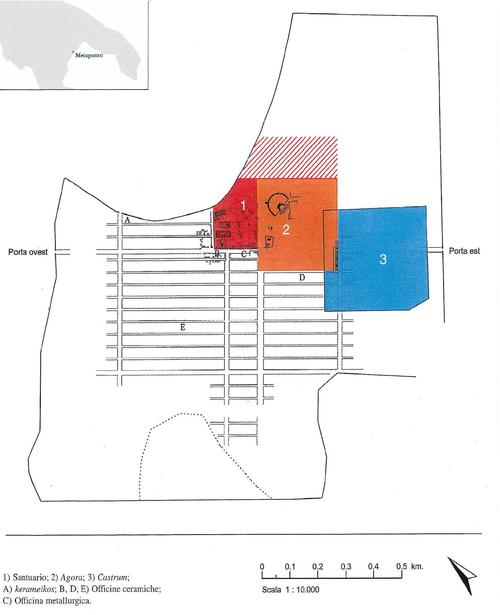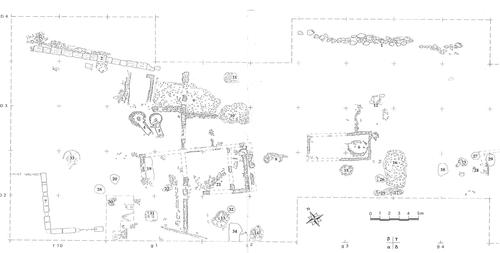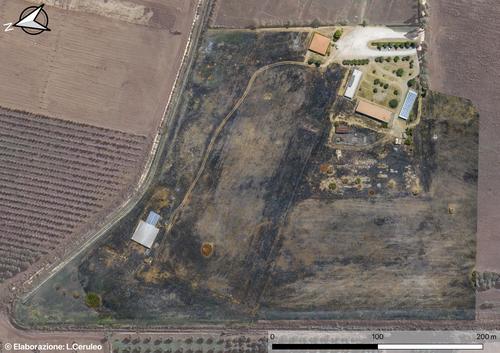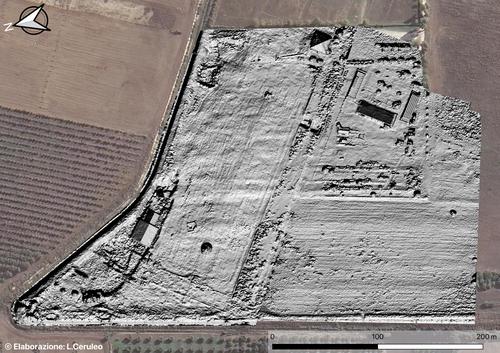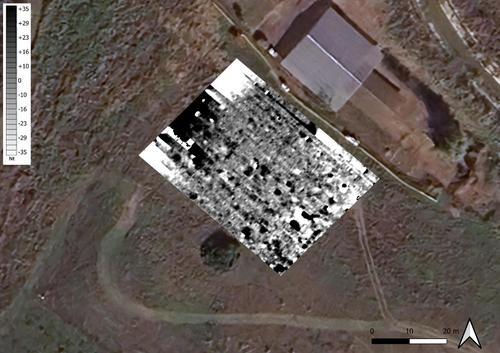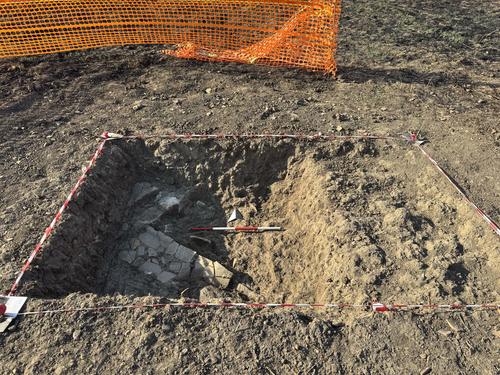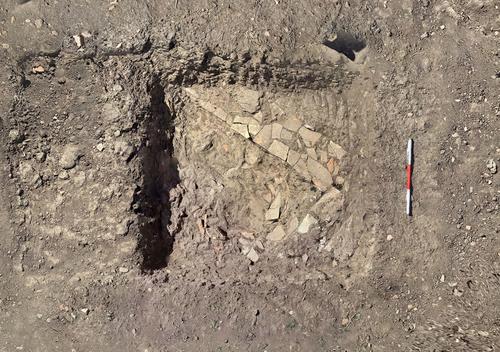The Kerameikos of Metaponto
Fig. 1. Reconstructed plan of Metapontum
Bildquelle: Cracolici 2003
Fig. 2. Plan of Kerameikos after D’Andria's excavation
Bildquelle: Cracolici 2003
Fig. 3. Investigation area.
Bildquelle: Lorenzo Ceruleo
Fig. 4. Digital Elevation Model of the survey area.
Bildquelle: Lorenzo Ceruleo
Fig. 5. Results of the magnetometry
Bildquelle: ATS SRL
Figs. 6. Trench 1
Bildquelle: Sabatino Martello
Figs. 7. Trench 1
Bildquelle: Sabatino Martello
The Kerameikos of Metaponto: Organization of Production, Crafts Activities and Human–Environment Interactions in a Greek Colony
Principle Investigator: PD Dr. Chiara Blasetti Fantauzzi
Excavation in cooperation with the Direzione Regionale Musei Nazionali Basilicata (Dr. Filippo Demma), the Museo Archeologico Nazionale di Metaponto (Dr. Vincenzo Cracolici), and the University of Viterbo (Prof. Dr. Salvatore De Vincenzo)
State of Research
In recent decades, significant advances have been made in the study of ancient craft quarters. The Kerameikos of Athens is regarded as the most thoroughly documented example of an integrated urban production center located on the periphery of the city, while Selinus in Sicily has revealed a peripherally located industrial quarter with more than eighty kilns. In contrast, the cities of Magna Graecia present a more heterogeneous landscape characterized by diverse patterns (Bentz et al. 2013; Monaco 2000; Rizzo 2019; Segbers 2019).
Within this framework, the Kerameikos of Metaponto stands out as a deliberately planned ceramic quarter integrated into the orthogonal street system (Fig. 1, A). Continuous use is attested from the 6th to the 3rd century BCE. Excavations initiated in 1973 uncovered walls, kilns, and systematically organized refuse deposits (scarichi) (Fig. 2). Scarico 1, in particular, has been linked to the workshops of the Painters of Creusa and Dolone, while other contexts can be associated with the Anabates Painter (D’Andria 1980; Cracolici 2003; Silvestrelli 2004, 2018).
Despite these important findings, the state of research remains fragmentary. Many structures are still unexcavated, leaving fundamental questions regarding the layout, function, and organization of the quarter unanswered (Osanna 1996). Recent geomagnetic surveys and excavations (2025), conducted in collaboration with the University of Bamberg (Dr. Wieke de Neef), have revealed an unexcavated area of roughly two hectares containing kilns and associated structures (Figs. 3–7).
Research Aims and Questions
The project aims to investigate the Kerameikos of Metaponto as an integrated urban production center within the context of a Greek colony. The research will reconstruct the dynamics of craft production and its interrelations with the urban environment and the surrounding landscape. Key research questions include:
- How was the Kerameikos functionally and spatially integrated into the urban layout of Metaponto?
- How can the production phases and internal spatial organization of the Kerameikos be reconstructed from a diachronic perspective?
- What role did specialization, division of labor, and resource management play in structuring the production process?
- Which social and economic structures shaped the organization and long-term development of the Kerameikos?
The overarching goal is to reconstruct human–environment interactions within the craft quarter of Metaponto, with particular attention to resource use, landscape transformation, economic dynamics, and social structures.
Methods
The project employs an interdisciplinary approach integrating archaeological excavation, geophysical survey, remote sensing, sediment analysis, and GIS-based spatial studies to achieve a comprehensive understanding of the production quarter.
Targeted stratigraphic excavations will be carried out in both previously documented contexts, such as refuse deposits (scarichi) and kilns, as well as newly identified areas. Special attention will be given to the correlation between production structures (kilns, workshops, workspaces), waste deposits, and circulation routes to clarify the organization of space and labor.
Expected Results
The excavations aim to establish a secure stratigraphic sequence linking production processes with waste deposits and kilns, allowing for a reconstruction of the entire production cycle. The identified workshop areas will offer new insights into internal organization, workforce requirements, and the scale of operations.
Additionally, the project is expected to generate robust models of raw material procurement and distribution routes, highlighting the mobilization of local resources within broader exchange networks.
From an urban historical perspective, the results will clarify the functional separation between residential and productive zones, revealing the intentional integration of specialized craft activities into the city’s orthogonal grid.
For ceramic studies in Magna Graecia and South Italy, the project will refine the chronologies of the 6th to 3rd centuries BCE and provide a stronger contextualization of Metapontine workshops within the wider networks of artisan mobility and stylistic development along the Ionian coast.
Ultimately, the Kerameikos of Metaponto will serve as a model for sustainable production systems in Greek colonial contexts and as a benchmark for comparative studies of craft, urbanism, and environment in the ancient Mediterranean.
BIBLIOGRAPHY
Bentz et al. 2013: M. Bentz – L. Adorno – J. Albers – J. M. Müller – G. Zuchtriegel, Das Handwerkerviertel von Selinunt. Die Töpferwerkstatt in der Insula S 16/17-E. Vorbericht zu den Kampagnen 2010–2012, RM 119, 2013, 69–98.
Cracolici 2003: V. Cracolici, I sostegni di fornace dal kerameikos di Metaponto (Bari 2003).
D’Andria 1980: F. D’Andria, Scavi nella zona del Kerameikos, in D. Adamesteanu – D. Mertens – F. D’Andria, Metaponto I, NSc XXIX, 1975, Suppl. (Roma 1980) 355–452.
Monaco 2000: M. C. Monaco, Ergasteria. Impianti artigianali ceramici ad Atene ed in Attica dal protogeometrico alle soglie dell'ellenismo, in Studia archaeologica 110, 2000.
Osanna 1996: M. Osanna, Metaponto, in: I Greci in Occidente. Arte e artigianato in Magna Grecia (Napoli 1996) 44–49.
Rizzo 2019: M. L. Rizzo, Aree e quartieri artigianali in Magna Grecia, in Ergasteria 9, 2019.
Segbers 2019: A. Segbers, Töpferhandwerk in der Magna Graecia (Bonn 2019).
Silvestrelli 2004: F. Silvestrelli, L'archeologia della produzione in Magna Grecia. Il caso del Kerameikos di Metaponto, in: Metodi e pratica della cultura materiale: produzione e consumo dei manufatti (Bordighera 2004) 107–116.
Silvestrelli 2018: Il repertorio morfologico delle ceramiche fini di Metaponto. Caratteristiche e trasformazioni nel V e nel IV secolo a.C., in C. Pouzadoux – M. Denoyelle – F. Silvestrelli (eds.), Ricerche sulla ceramica italiota I. Mobilità dei pittori e identità delle produzioni (Napoli 2018) 135–160.

